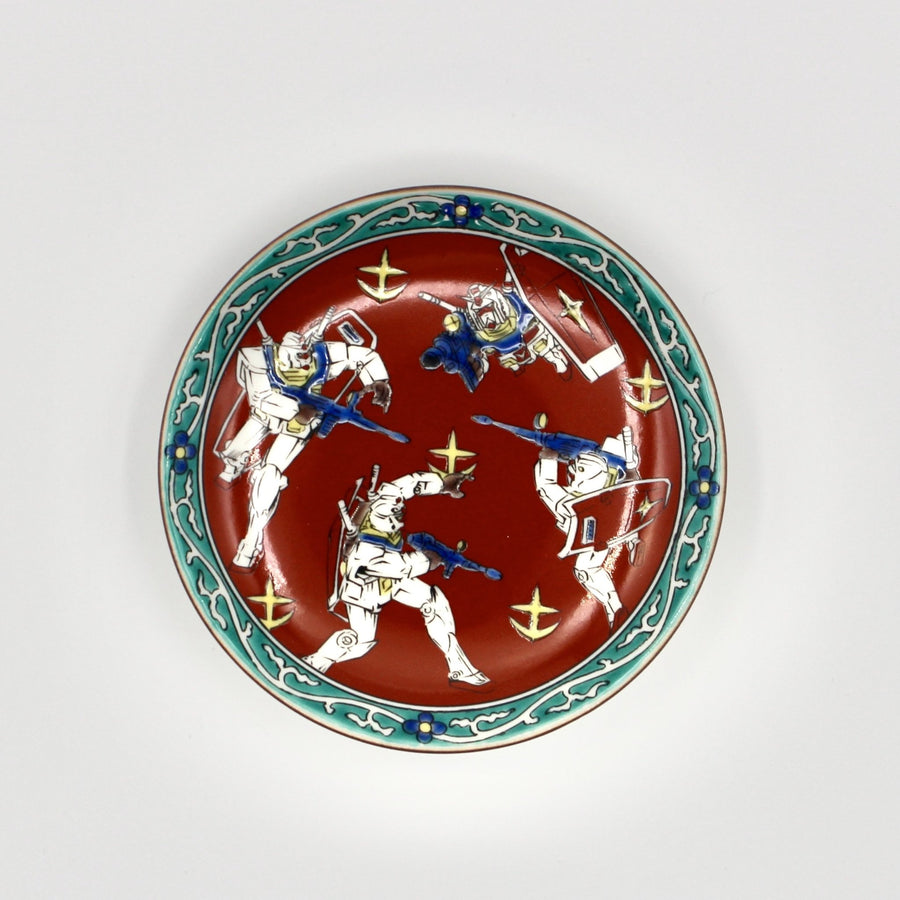Have you ever wondered what Kutani ware is and wanted to know about its history and background?
Kutani ware is a ceramic ware born in what is now Kaga City, Ishikawa Prefecture. The history of Kutani ware began with Ko-Kutani, and kilns were opened in various regions, including the Kasuga-yama, Yoshida-ya, and Iida-ya kilns. Kutani ware, one of Japan's representative traditional crafts, continues to win the hearts of many fans.
This article describes the characteristics of Kutani ware, its history, and representative styles. We also introduce the production process, so please read to the end.
1. What is "Kutani ware"? Its Characteristics and Attractions

Kutani ware is a ceramic produced in Kaga, Kanazawa, Komatsu, and Nomi cities in Ishikawa Prefecture. Kutani ware came to be called "Kutani ware" because the kilns were built in Kutani Village (present-day Yamanaka Onsen Kutani-machi, Kaga City), a production area for pottery stones.
The main attraction of Kutani ware is the vivid colors created by overglaze painting. The excellence of the painting is such that there is a saying, "Kutani does not exist apart from its painting”.
Overglaze painting refers to a technique in which pigments are applied to ceramics after firing and then fired again. The advantage of firing at a lower temperature of 800 degrees Celsius is that the paint is firmly fixed in the vessel, which allows for a wider variety of paints to be used.
Another characteristic of Kutani ware is that each kiln has a different style, such as using five colors (red, green, yellow, purple, and navy blue) or using red as the base color. Even today, many new designs are being created while preserving the traditions of Kutani ware.
For your information, both pottery and porcelain exist in Kutani ware. Pottery has a chubby appearance and makes a dull sound when struck with a finger. Porcelain, on the other hand, has a smooth surface that makes a metallic sound when struck with a finger.
To tell them apart, check the foot rings at the bottom of the vessel. If you see the color of the clay, it is pottery.
2. The history of Kutani ware
The history of Kutani ware dates back to the early Edo period.
Kutani ware was born in the early Edo period
Kutani ware is said to have been born in 1655, in the early Edo period.
This was triggered by the discovery of high-quality pottery stone during the development of a mine in Kutani Village (present-day Yamanaka Onsen Kutani-machi, Kaga City, Ishikawa Prefecture), which was part of the Daishoji domain. Toshiharu Maeda, the first lord of the Daishoji domain, ordered Saijiro Goto, a feudal retainer, to go to Hizen Arita to learn pottery-making techniques.
Upon his return, Goto opened a kiln in Kutani, but after about 50 years, the kiln suddenly closed. The reasons for this are still unclear, although some have been postulated.
Kutani ware produced during this period is called "Ko-Kutani" and is still highly valued today.
Restored about 100 years later as the "Revival Kutani”
Even after the kiln closed, it is believed that the techniques of Kutani ware were quietly passed down from generation to generation. And about 100 years later, a movement to revive Kutani ware began in the Kaga domain.
The Kaga domain invited Mokubei Aoki from Kyoto to open the Kasuga-yama Kiln in Kanazawa. This led to the opening of the Yoshida-ya kiln in the Daishoji domain as well. The central figure in this effort was Denemon Toyoda, a wealthy merchant from the Daishoji domain, who was highly regarded by the wealthy and intellectuals of the time.
The name of the kiln comes from Toyoda's trade name (Yoshida-ya).
However, Yoshidaya Kiln's pursuit of quality without regard to profitability put pressure on the business, and the kiln was closed only seven years after opening. After that, Miyamotoya Uemon, the on-site manager of Yoshidaya Kiln, took over and reopened the kiln as Miyamoto-ya Kiln.
Other kilns were also opened in various locations, including the Eiraku Kiln and the Shozo Kiln.
Kutani ware born during this period is known as "Revival Kutani".
Export business has flourished since the Meiji Era
In the Meiji period, the export industry flourished due to the industrial rehabilitation policy of the Meiji government. This was because the transfer of power from the Edo shogunate to the Meiji government meant that the potteries no longer received support from the domains.
As a result, craftsmen from the Daishoji domain further developed their quality, and many became independent artisans and artists. Examples of famous ceramic artists include Suda Koka First and the brothers Takeuchi Ginshu and Asai Ichimou.
Meanwhile, craftsmen from the Kaga domain, led by Kutani Shoza, produced many pieces for the American and European markets. The technique called "Saishoku Kinrande" (colored gold brocade), created by Kutani Shozo, gained a reputation as "Shozo Style”.
Kutani ware was highly acclaimed abroad, and was exhibited at the Vienna World Exposition in 1873 as "Japan Kutani," spreading its fame throughout the world.
A wide variety of Kutani ware is being produced today
From the late Showa period onward, Kutani ware went beyond the boundaries of a craft, and began to be produced as a work of art. It has also been used as gifts from the Imperial Household Agency and offered as a wedding celebration to Prince Charles of the United Kingdom.
Kutani ware has come to be produced in a wide variety of designs depending on the artist and lifestyle. Leading the way for today's artists are father and son, Kitade Tojiro and Fujio, who introduced exotic Middle Eastern designs and carved decorations.
Tokuda Yasokichi Third and Yoshida Minori, who produced elegant Kutani ware, are recognized as Living National Treasures.
3. Representative styles of Kutani ware
Here are some of the representative styles of Kutani ware.
Kokutani

Uses the five colors of red, green, yellow, purple, and navy blue known as "Kutani Gosai (five colors of overglazed enamels)" and the four colors of green, yellow, purple, and navy blue known as "Aode (blue overglazed enamels).
Characterized by dynamic composition and powerful painting.
Mokubei
The entire surface is painted red with Chinese-style figures in five colors.
Yoshida-ya

Use four colors: green, yellow, purple, and navy blue.
The entire vessel is filled without gaps with patterns and fine patterns, having a profound atmosphere.
Miyamoto-ya, Iida-ya

The style is based on red, and the figures and patterns are painted so meticulously.
Glazed gold in places gives it an elegant and beautiful impression.
Eiraku

The entire surface is painted red, and delicate designs are drawn over it with gold paint.
It has a strong impact.
Shouza
The techniques of Ko-Kutani, Yoshida-ya, Akae, and Kinrande are used.
Its blended style of Japanese and Western has become mainstream since the Meiji era.
4. Production process of Kutani ware
The production process of Kutani ware is as follows. Overglaze painting allows the glaze to set when fired, resulting in colors that are both vivid and transparent.
Glaze is a liquid that turns glassy when fired at high temperatures and acts like a film covering the vessel. Glazing is a process in which the craftsman's skill is crucial, as the glaze must be applied evenly.
- Mining and breaking the ceramic stone into small pieces
- Mixing water and ceramic stone to "filter" and remove impurities
- Letting it rest for a certain period of time when it reaches the proper firmness
- Kneading to remove air
- Molding (using the "Rokuro" method, in which clay is rotated to form shapes, or "Tebineri" method, in which clay stretched into strings is piled up)
- Drying thoroughly under the sun
- Unglazing it for about 8 hours at about 800-900 degrees Celsius
- Underglazing and applying glaze evenly
- Fired at a high temperature of about 1300 degrees Celsius for about 15 hours
- Overglazing
Firing at about 800 degrees Celsius for about 4 to 10 hours using an overglaze kiln.
5. Kutani ware has also collaborated with popular characters
Kutani ware includes a wide range of products, from everyday use vessels to those that you would want to display as works of art. Some of these products are collaborations with popular characters. Characters that have collaborated with Kutani ware include Snoopy from Peanuts, Doraemon, and Moomin, all of which are strongly beloved.
If you are interested in Kutani ware, but are nervous about buying a high-end plate out of the blue, you can start by choosing a Kutani ware with a cute character design. It is also recommended as a gift or a souvenir.
6. Summary
Kutani ware is a ceramic that is believed to have been created in the early Edo period. Although the kiln was once closed, numerous kilns have been opened since its revival. Today, it has become a traditional craft loved around the world.
If you are interested, you can visit Kaga City, Ishikawa Prefecture. There are several places where visitors can observe the manufacturing process of Kutani ware or try their hand at painting.









